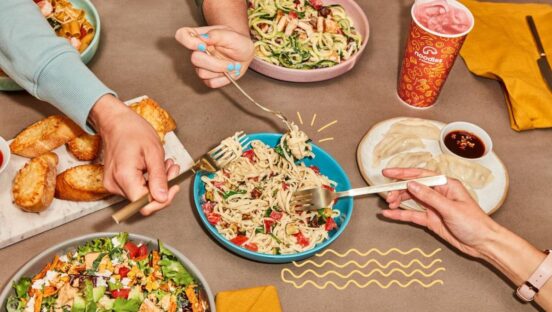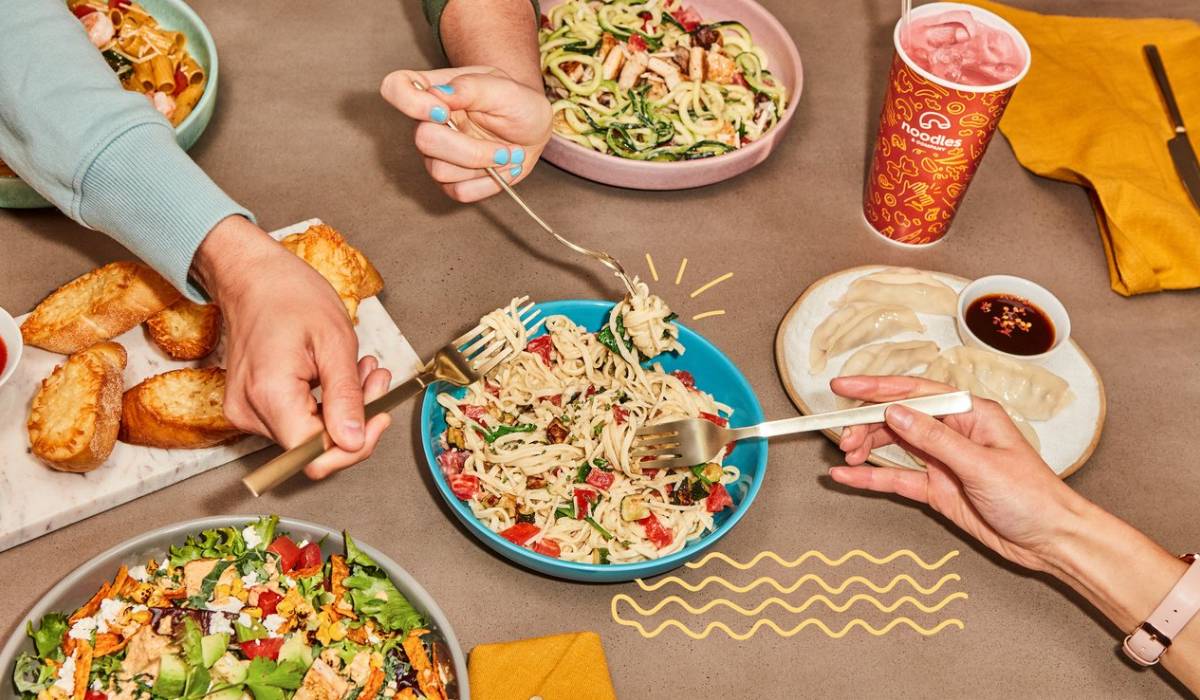Guests pushed back on higher menu prices at Noodles & Company in Q1. CEO Dave Boennighausen said the opposition has manifested in the delivery channel, which saw a “meaningful decline” in sales in the back half of the quarter.
“Although we believe the trend of reduced delivery sales is consistent with others in the industry seeing the shift from delivery to on-premise ordering, we additionally believe that we are seeing resistance to our prior price increases, presenting themselves in our overall traffic trends,” he said during the company’s Q1 earnings call on Wednesday.
In particular, Noodles & Company saw a reduction in conversion rates during the checkout process on its digital channels, as well as a reduction in frequency from lower- and middle-income cohorts, which make up around 45 percent of its customer base. Along with the higher prices, customers ordering through third-party delivery channels pay a 25 percent premium, which helps the company offset fees charged by aggregators.
Pricing during the quarter was just above 10 percent, driven by a 5 percent increase taken across the core menu in mid-February. At its height, Noodles & Company was carrying 13 percent of price during the latter half of Q1 and into the first half of Q2. Since then, it has lapped its primary pricing activity from last year, and CFO Carl Lukach expects it will run meaningfully lower prices throughout the remainder of the year.
Boennighausen said the higher prices were necessary in the face of soaring commodity and labor costs. The company responded to those inflationary pressures with a slew of cost-saving and productivity initiatives, including entering into fixed contracts for chicken, which saw “unprecedented inflation” last year.
READ MORE: Noodles & Company Doubles Down on Digital Capabilities
The fast-casual chain recently rolled out a simplified menu that features 10 percent fewer items. Using data from its rewards program as well as other third-party sources, it identified items that were difficult to execute from an operational perspective and had clear substitutes from the existing menu. Boennighausen pointed to the company’s Orange Chicken dish as an example of an operationally challenging item that was removed with no negative impact.
“Our mix in the Asian category remains the exact same,” he said. “We were able to move all of those people into our Japanese Pan Noodle, our Korean Beef, or our Pad Thai. We found all of that through testing. And importantly, from the operational side, we saw significant cook-time improvements. We saw better 90-day retention rates as people were able to be trained easier.”
Noodles & Company began rolling out digital menu boards nationwide, which Boennighausen said provides more flexibility for executing real-time marketing and pricing strategies. It also engaged with the consulting firm Profitality to identify opportunities to streamline operations in existing restaurants and reduce its footprint needs for future new restaurant builds.
The impact of those initiatives was evident in the 400 basis points of restaurant-level margin expansion the company experienced in Q1. Restaurant contribution margin increased from 9.7 percent a year ago to 13.7 percent, culminating in adjusted EBITDA of $7 million, a $4.8 million increase from Q1 of 2022. Systemwide same-store sales were up 6.4 percent, including a 6.9 percent increase at company-owned restaurants and a 4.1 percent increase at franchised restaurants. AUVs grew 7.5 percent to $1.34 million.
Cost of goods sold improved 280 basis points to 25.2 percent of sales, driven by the benefit of the company’s contracted food vendors as well as improvements in the commodity market for its formula-based ingredients. Labor costs were flat from last year at 32.3 percent of sales. Wage inflation was approximately 9 percent but improved sequentially throughout the quarter.
Boennighausen said the company continues to see favorability in its expense profile, particularly in commodities, which he expects will have low single-digit deflation for the full year relative to 2022.
A more favorable expense environment enabled Noodles & Company to quickly pivot and refocus on value propositions. Earlier this month, it brought back its 7 for $7 menu, which includes popular dishes like Wisconsin Mac & Cheese, Japanese Pan Noodles, Pesto Cavatappi, Pasta Fresca, Buttered Noodles, and more. It also introduced a $10 Mac and Cheese meal that includes a drink and dessert.
“We have already seen a nice response to our value offerings with sales stabilizing and traffic declines improving,” Boennighausen said. “These offerings are on some of our most favorable margin items and when combined with other value-focused promotions, give us the opportunity to provide value while still maintaining strong profitability.”
Noodles and Company first launched its 7 for $7 menu last fall, and Lukach said the marketing campaign around the platform was “extremely effective in driving value perception and traffic.” Now, the company is taking a similar approach to driving traffic and attracting price-sensitive customers.
“As we launch a higher level of traffic-driving marketing spend during the second quarter, we expect discounts to offset the better-than-expected cost of goods sold environment,” Lukach said. “Importantly, while these initiatives are expected to negatively impact cost of goods sold, we expect they will be accretive to restaurant margin dollars.”
Many of those traffic-driving initiatives are specifically designed to bolster enrollment in the company’s rewards program, which grew 14 percent to 4.7 million members in Q1. Frequency among reward members increased 3 percent in the quarter.
Staffing metrics also are improving, with both year-to-date hourly and general manager turnover roughly 30 points below 2022 levels. Those improvements have translated into gains across key operational metrics, including cook times and net promoter scores.
Boennighausen said the improvement in people metrics is critical as Noodles & Company continues to ramp up development. Its goal is to achieve a 7.5 percent increase in gross new units this year. Three new company-owned restaurants opened in Q1, and 6-7 new stores are slated to open in Q2.
The company ended Q1 with a total of 461 restaurants, including 369 company-owned restaurants and 92 franchised restaurants.




